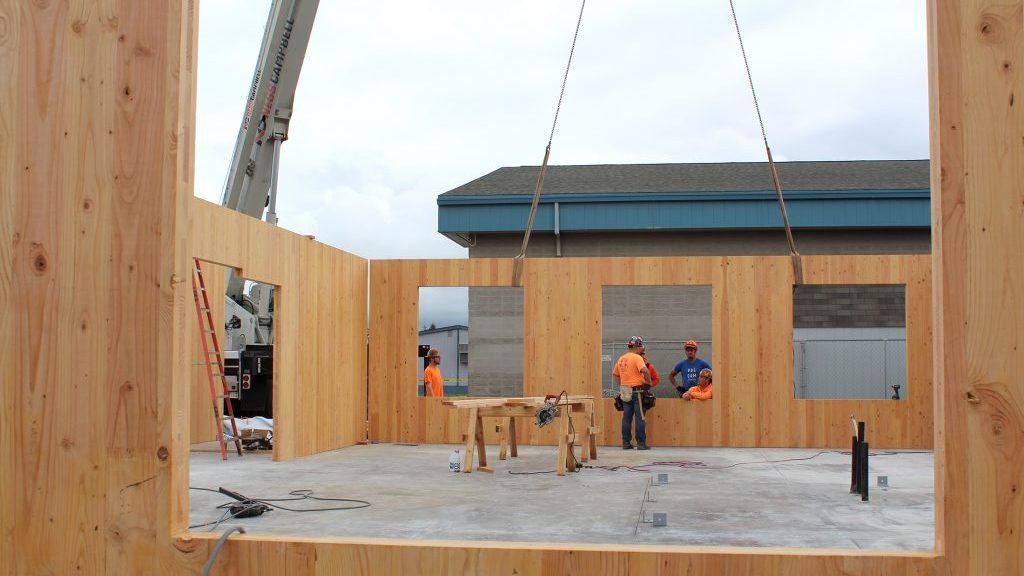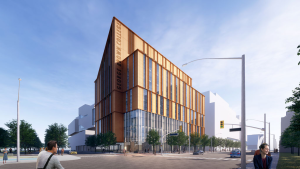Mass timber construction is making waves on both sides of the Canada-U.S. border, but factors in each country mean a different pace of progress.
The state of Washington is rapidly moving forward on both green construction and use of advanced wood products, but Washington State Department of Commerce forest products sector lead Brian Hatfield said the state isn’t necessarily ahead of its Canadian neighbour.
“In some ways, British Columbia is ahead of us in terms of low carbon building materials,” he said.
In 2017, the Washington State Department of Enterprise Services oversaw a pilot project that built 20 kindergarten through Grade 3 classrooms using cross-laminated timber (CLT) in five school district sites in Washington.
“We had a pilot district for five school districts, all single storey schools, and those have gone pretty well. They went up quickly and everyone was impressed,” Hatfield said.
The state’s 2016 supplemental capital budget included $5.5 million for the pilot project, which also measures the efficiencies of using engineered wood product through the construction process.
While Washington is taking steps to increase wood use in construction, the Province of British Columbia has pushed for mass timber and wood-focused design for the previous decade. In 2009, the Province of British Columbia put the Wood First Act into practice, which requires provincially funded projects to use wood as a primary construction material. The B.C. building code was also modified in 2009 to allow for wood buildings of up to six storeys.
“It’s interesting Washington is looking to increase mass timber use in schools,” said Wood WORKS! BC executive director Lynn Embury-Williams. “It’s a terrific move as schools are public buildings, paid for by the state, which will help them evolve the expertise and experience to further develop wood buildings.”
Embury-Williams said both the federal and provincial governments are eager to see a range of different types of wood-based buildings going forward, and that Washington state is “trying to get a similar type of legislation off the ground.”
“They aren’t there yet, but my guess is they will get there at some point,” she said.
Hatfield said advanced wood building is gaining traction in the state legislature.
“We’ve certainly seen a lot of legislative support for wood building in general. This past session, the state passed SB 5450, which says the state building code sets the rules for mass timber use. That piece of legislation passed in the senate 46 to two, and in the house 91 to six,” Hatfield said.
“There’s more and more legislators with ideas, and now we have to reign in those ideas to what’s possible and what’s fair.”
Hatfield also pointed to changing the building code at both the state and national level as key to more wood construction.
“It’s an interstate and international issue. We can get things changed in Washington State and in Seattle on a case by case basis using the proposed code, but the idea is to get into the International Code Council (ICC) so it’s any state, anywhere,” Hatfield said.
The ICC is a sister organization to the Canadian Wood Council, Embury-Williams said, and they have similar codes.
“The Canadian code is re-examined every five years, and the U.S. code every three years. The codes are fairly aligned, but the Canadian code will allow for wood buildings up to 12 storeys, and it’s out for public review right now,” she said.
The U.S. code has developed differently and allows for buildings up to 18 storeys, but currently there are no wood buildings close to that height in the United States, Embury-Williams said.
Vancouver-based Michael Green Architecture (MGA) did work on T3, a seven-storey mass timber building in Minneapolis. But other ambitious CLT projects, such as the 12-storey Framework building in Portland, Oregon and a 10 storey timber residential building on New York City’s High Line are currently on hold.
B.C. has a more developed production pipeline as does the rest of Canada, and “with every building that actually goes ahead, there’s a huge learning curve, so for the next project that becomes best practices,” Embury-Williams said.
Hatfield pointed to a planned Katerra factory set to open in Spokane, Wash. in 2019 which will produce cross-laminated timber wall panels, cross-laminated timber floor systems and glulam structural beams.
“Structural panels can help with the labour shortage in Washington state, and the whole concept of A to Z construction offsite could really change the building industry,” Hatfield said.
Katerra recently partnered with MGA, one of the leading Canadian firms working in mass timber construction.










Recent Comments